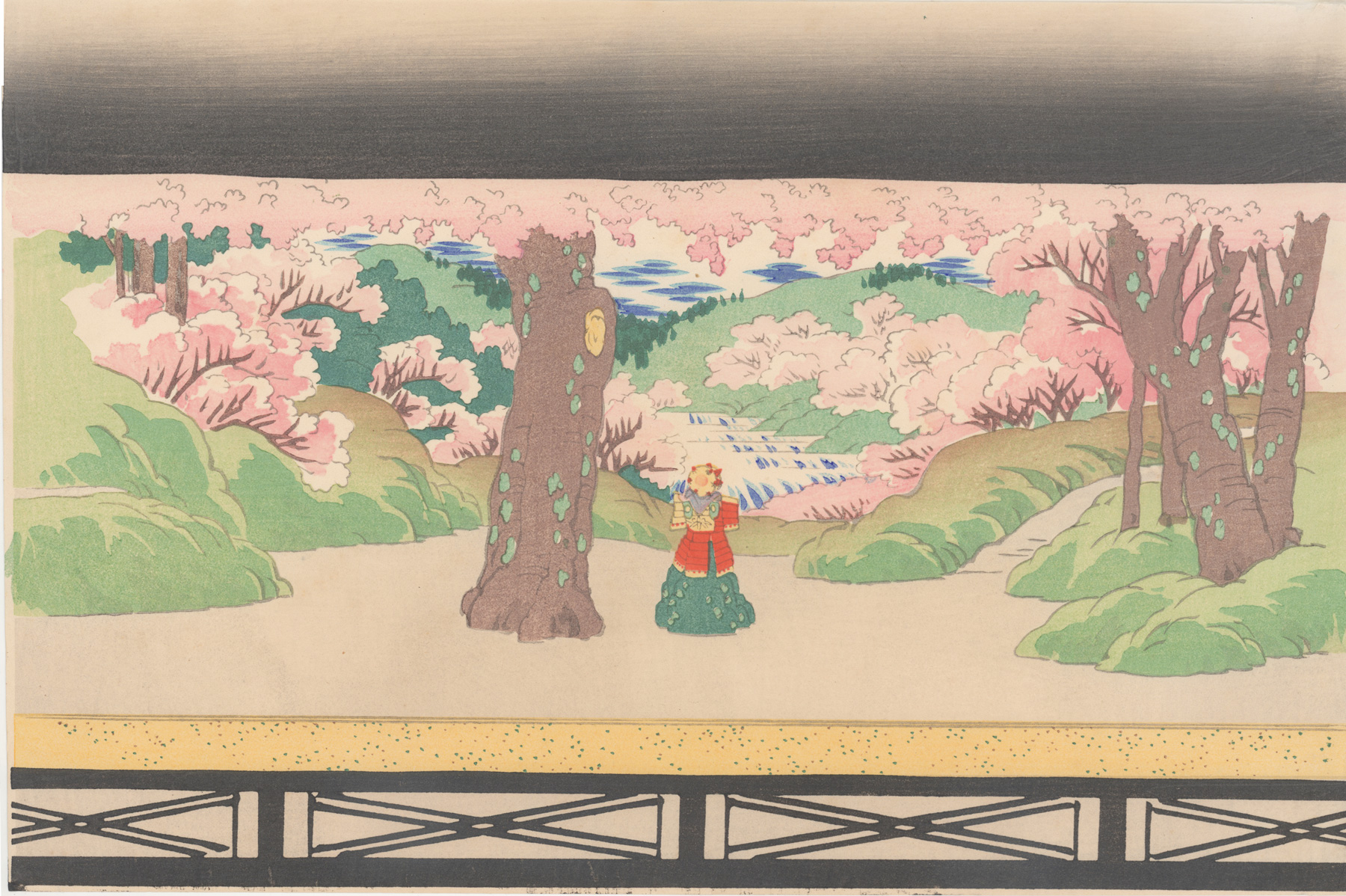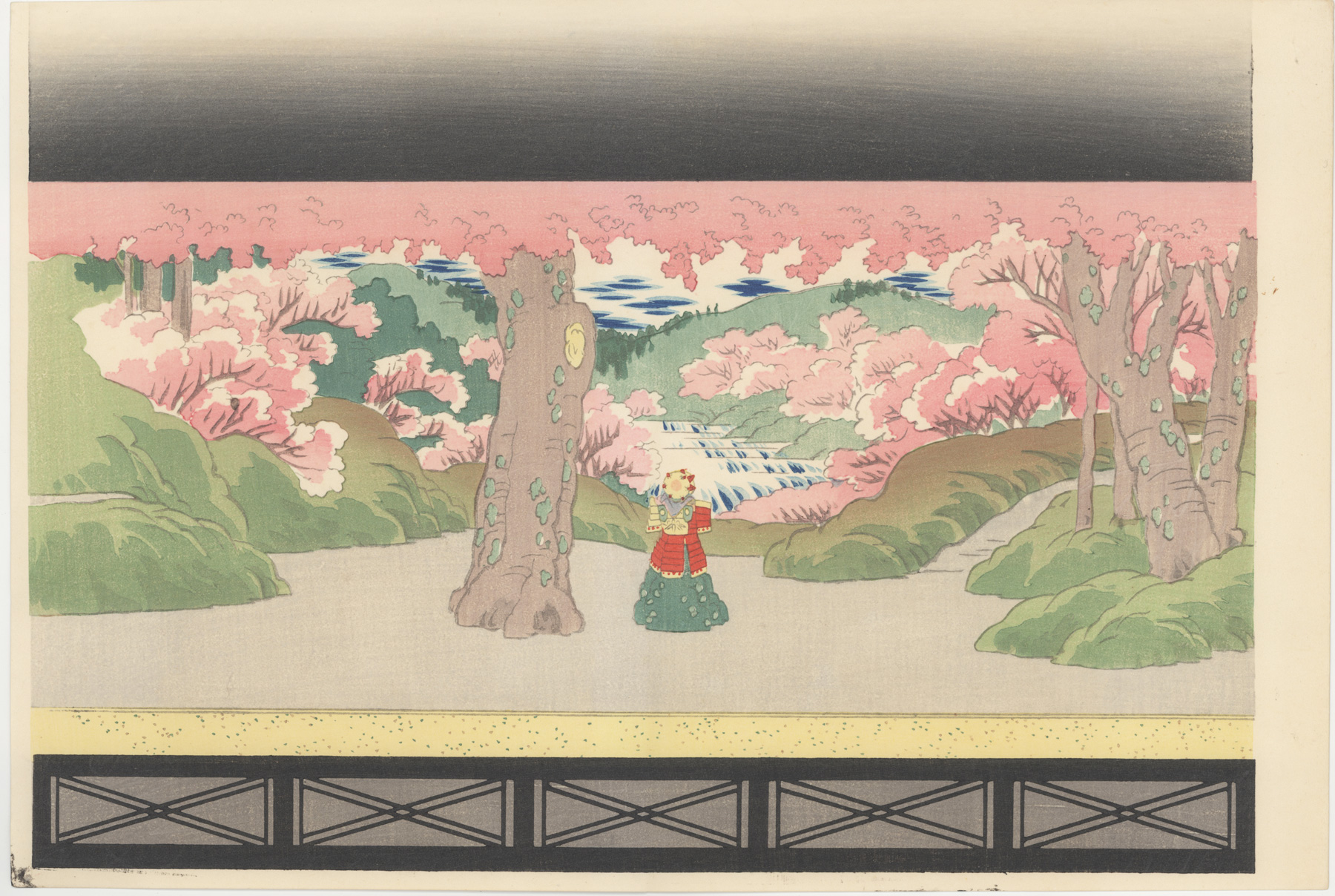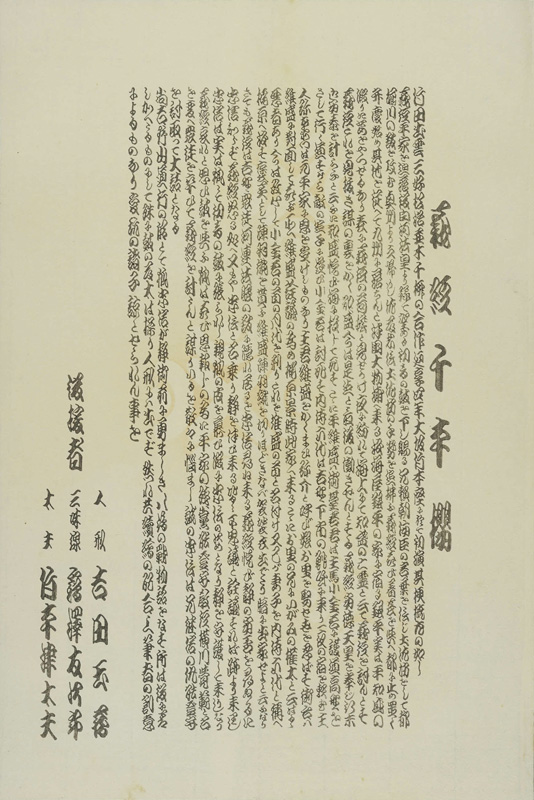About This Print
Two editions of an illustration of the stage set for the travel dance [michiyuki] on Mount Yoshino, "the journey with the drum", in the play Yoshitsune senbon zakura [Yoshitsune and the Thousand Cherry Trees] written by Takeda Izumo II (1691-1756), Miyoshi Shōraku (1696-1772) and Namiki Senryū (1695-1751) and first staged in November 1747. Yoshitsune's armor and the hand drum are at the center of the set.The play is one of the “Three Masterpieces” of the puppet theater along with Sugawara Denju Tenarai Kagami and Kanadehon Chūshingura. It was written in 1717 by Takeda Koizumo (Izumo II) (1691–1756), Miyoshi Shōraku (1696-1772) and Namiki Sōsuke (Senryū) (1695-1751).
The top print, issued in 1926 came with a tissue overlay showing the outlines of the three puppets positioned on the stage. The later edition, likely post-WWII, does not have this overlay.
Brief Plot Summary
The play is a dramatization of the legend of Yoshitsune, younger brother of the Shogun Yoritomo, and the fugitive generals of the Heike Clan, Koremori and his uncle Tomomori, after its defeat by the Genji Clan headed by Yoritomo. The Sushiya and Michiyuki scenes in this play are especially famous.
Bunraku Stage Set

Stage Set for Ehon Taikoki (Records of the Taiko)
image source: website of Japan Arts Council Invitation to Bunraku
Source: Bunraku: The Art of the Japanese Puppet Theatre, Donald Keene and Hiroshi Kaneko, Kodansha International, Ltd., 1965, p. 22.
For those unfamiliar with the stage set for bunraku the following passages from Donald Keene's Bunraku: The Art of the Japanese Puppet Theatre are instructive:
"Soon after the chanter enters his description of the new scene, the curtain is drawn aside to reveal the set, a naturalistic rendering of a landscape or interior. If the backdrop represents an outdoor scene, it is painted on a series of vertical panels which may be moved laterally to suggest that characters (who remain in one place) are traveling. If an interior, the gate, framework of the house, and generally one room are depicted, with the suggestion of other rooms beyond. A garden or nearby building may also be represented. A doorway at the rear-center of the stage is usual, for it permits the female characters to make spectacular exits, displaying their figures from behind. Very few props are used; unless necessary to the action, the furnishings are generally painted on the backdrop, to allow the operators the maximum freedom of movement.
The Bunraku stage, traditionally 36 feet wide, 25 feet deep, and 15 feet high, is divided into various playing areas. The main stage occupies about half the total area, and often serves as the interior of a house. Three raised partitions of different heights run across the width of the stage, standing before the trench-like passages in which the operators work. The partitions conceal the lower half of the principal operator's body, more of the operator of the left hand (who does not wear high-platformed clogs), and almost all of the operator of the feet; at the same time, they provide the apparent floor or ground level on which the puppets walk or sit. To the audience's right is a dais projecting into the auditorium from the stage. There the chanter perches on bulky cushions before an elaborately fashioned reading-stand; to his left, the samisen player sits on a single cushion, dwarfed by the chanter."
The Other Prints in the Yoshitsune senbon zakura Set
As further explained below, each stage set print was part of a set of five prints consisting of a black and white explanatory sheet and three portraits of puppet characters appearing in the play.
explanatory sheet
義経千本桜 Yoshitsune zenbon sakura
Source: Ritsuemikan University Art Research Center arcBK06-0002
click on image to enlarge

The four print set for Yoshitsune zenbon sakura
puppets from left to right (as positioned on the stage set print's tissue overlay):
Tsuzumi Tōta 皷藤太, Kitsune Tadanobu 狐忠信, Shizuka Gozen 静御前
About the "Illustrated Collection of Famous Japanese Puppets of the Osaka Bunrakuza"
This collection of forty-eight color woodblock prints was designed by Hasegawa Sadanobu III (Konobu III) (1881-1963) and issued over the period March 1926 (Taishō 15) to August 1927 (Shōwa 2)1 by the publishing houses Bijutsusha 美術社 in Tokyo and on a subscription (members only) basis by Hangakai hanmoto 版画会板元 (板畫會板元) in Kyoto. The cost per print set was 3 yen. The editor and publisher for both the Bijutsusha and Hangakai hanmoto sets was Hayashi Eikichi 林榮吉, who was also the editor for Hasegawa's Collection of One Hundred Kumadori Makeups in Kabuki. (See Hasegawa Sadanobu III (Konobu III) (1881-1963) for prints from this collection.)
The Illustrated Collection of Famous Japanese Puppets of the Osaka Bunrakuza consists of twelve sets of prints each set depicting a specific play in the bunraku repertory, as listed in the below table. Each set contains a stage set for the specific play along with three prints of puppet characters appearing in the play and an explanatory sheet, for a total of forty-eight color woodblock prints and twelve monochrome explanatory sheets. Each of the stage set prints was originally issued with a tissue overlay showing the position of the three puppet characters on the stage. All of the plays pictured were performed at the Bunraku Theater (Bunraku-za) located within the Goryō Shrine compound in Osaka. The Goryō Bunraku-za burned down in November 1926 after what has been described as "an extremely difficult managerial era" and "lost interest" by the public in the late Taishō era.2 It is unknown what role, if any, the management of the Goryō Bunraku-za may have played in the formulation and issuance of this print series in their efforts to revitalize the theater.
For more complete information on this series see the article Illustrated Collection of Famous Japanese Puppets of the Osaka Bunrakuza
1 Dates are taken from the colophons on the envelopes containing the print sets in the Waseda University Archives2 National Diet Library website page http://www.ndl.go.jp/scenery/e/column/kansai/goryo_bunrakuza.html which provides a history of the Goryō Bunrakuza.
Play Name in Japanese Play Name in English 壇浦兜軍記
Dan-no-ura kabuto gunki Chronicle of the Battle of Dan-no-ura 義経千本桜
Yoshitsune senbon zakura Yoshitsune and the Thousand Cherry Trees 一の谷嫩軍記
Ichi-no-tani futaba gunki Chronicle of the Battle of Ichinotani 仮名手本忠臣蔵、五段目
Kanadehon Chūshingura, go danme The Treasury of Loyal Retainers, Act 5 仮名手本忠臣蔵、七段目
Kanadehon Chūshingura, shichi danme The Treasury of Loyal Retainers, Act 7 伊賀越道中双六
Igagoe dōchū sugoroku The Revenge at Igagoe 心中天網嶋
Shinjū ten no amajima The Love Suicides at Amijima 新版歌祭文
Shinpan Utazaimon The New Scandalous Ballad of Osome and Hisamatsu 菅原伝授手習鑑
Sugawara Denju Tenarai Kagami Sugawara and the Secrets of Calligraphy 本朝廿四孝
Honchō nijūshikō Twenty-four Examples of Filial Piety 鎌倉三代記
Kamakura sandaiki Three Generations of Kamakura Shoguns 夏祭浪花鑑
Natsumatsuri Naniwa kagami Summer festival at Naniwa (Osaka)
| Play Name in Japanese | Play Name in English |
| 壇浦兜軍記 Dan-no-ura kabuto gunki | Chronicle of the Battle of Dan-no-ura |
| 義経千本桜 Yoshitsune senbon zakura | Yoshitsune and the Thousand Cherry Trees |
| 一の谷嫩軍記 Ichi-no-tani futaba gunki | Chronicle of the Battle of Ichinotani |
| 仮名手本忠臣蔵、五段目 Kanadehon Chūshingura, go danme | The Treasury of Loyal Retainers, Act 5 |
| 仮名手本忠臣蔵、七段目 Kanadehon Chūshingura, shichi danme | The Treasury of Loyal Retainers, Act 7 |
| 伊賀越道中双六 Igagoe dōchū sugoroku | The Revenge at Igagoe |
| 心中天網嶋 Shinjū ten no amajima | The Love Suicides at Amijima |
| 新版歌祭文 Shinpan Utazaimon | The New Scandalous Ballad of Osome and Hisamatsu |
| 菅原伝授手習鑑 Sugawara Denju Tenarai Kagami | Sugawara and the Secrets of Calligraphy |
| 本朝廿四孝 Honchō nijūshikō | Twenty-four Examples of Filial Piety |
| 鎌倉三代記 Kamakura sandaiki | Three Generations of Kamakura Shoguns |
| 夏祭浪花鑑 Natsumatsuri Naniwa kagami | Summer festival at Naniwa (Osaka) |
Print Details
| IHL Catalog | #2474, #1657 |
| Title or Description | Bunraku Theater Stage Set for Yoshitsune senbon zakura [Yoshitsune and the Thousand Cherry Trees] Bunraku ningyō butaizu Yoshitsune senbon zakura 文楽人形、舞台図、義経千本桜 静忠信道行 |
| Series | Illustrated Collection of the Famous Japanese Puppets of the Osaka Bunrakuza Ōsaka Bunraku-za Ningyō Gashū: Nihon Meibutsu 日本名物大阪文楽座人形画集 |
| Artist | Hasegawa Sadanobu III (Konobu III) (1881-1963) |
| Signature | not signed |
| Seal | not sealed |
| Publication Date | IHL Cat. #2474: April 1926 (Taishō 15) IHL Cat. #1657: not dated but likely post WWII |
| Publisher | IHL Cat. #2474: 美術社 Bijutsusha, Tokyo and 版画会板元 Hangakai hanmoto, Kyoto IHL Cat. #1657: Uchida Publishing |
| Carver | IHL Cat. #2474 :佐藤重一 Satō Jūichi IHL Cat. #1657: 佐藤重一 Satō Jūichi (if original woodblocks were used) |
| Printer | IHL Cat. #2474 :板垣八重松 Itagaki Yaematsu IHL Cat. #1657: unknown |
| Impression | IHL Cat. #2474: excellent IHL Cat. #1657: excellent |
| Colors | IHL Cat. #2474: excellent IHL Cat. #1657: excellent |
| Condition | IHL Cat. #2474: excellent IHL Cat. #1657: excellent |
| Genre | puppet theater stage set picture 文楽人形、舞台図 bunraku ningyō, butaizu |
| Miscellaneous | |
| Format | |
| H x W Paper | IHL Cat. #2474: 9 13/16 x 14 7/8 in. (24.9 x 37.8 cm) IHL Cat. #1657: 10 3/8 x 15 1/8 in. (26.4 x 38.4 cm) |
| H x W Image | IHL Cat. #2474: 9 13/16 x 14 7/8 in. (24.9 x 37.8 cm) IHL Cat. #1657: 10 1/8 x 14 3/8 in. (25.7 x 36.5 cm) |
| Literature | |
| Collections This Print | Waseda University Cultural Resource Database 201-1492 and 201-1542(A and B); Ritsumeikan University Art Research Center AcNo. arcBK06-002_10; National Diet Library Call Number 414.38; The Met Thomas J. Watson Library 240.3081 H27 Quarto; British Library System number: 018894603 |
5/13/2021
11/20/2018





